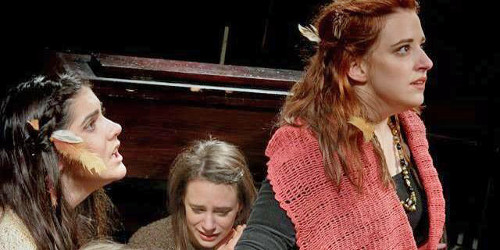By Bridgette M. Redman

Arthur Miller's "The Crucible" gets an intimate production at Great Escape Stage Company. Photo: GESC
Arthur Miller's "The Crucible" has always been a thinker. Miller had things he wanted to say in the Tony Award-winning play.
The 1959 drama about the Salem witch trials was Miller's protest against McCarthyism and the hysteria that surrounded the anti-Communism movement of the 1950s. Directors continue to choose the play to explore how ordinary people find their goodness amid crowd-driven witch hunts.
At Great Escape Stage Company, director Edward Kernish makes bold choices to ensure the audience knows this play is allegory and not limited to the Puritan times of 1692 to 1693. This play could be set any time where technology does not exist, even a post-apocalyptic future.
The stage is small, less than 10 feet across, with the audience to either side, seated as though they were in a jury box judging the proceedings. With a cast of 20, this means things often get crowded, though Kernish keeps people shifting and rotating to allow for entries and to limit the time any one character has his or her back to one side of the audience.
In this large cast, three actors in particular stood out.
The play's themes rotate around John Proctor, and it is necessary to have a strong actor to make this play work. Dyon Casey fills the bill with a multi-layered performance in which he avoids stereotypes and finds the real humanity in Proctor. Casey creates a Proctor who is flawed but ever striving after goodness, who is strong and hot-tempered, but can be gentle and loving. Casey plays the role with a confidence that makes him stand out and garners sympathy for Proctor. He is an everyman who is caught up in a situation beyond his control and made worse because of the guilt he feels after poor decisions he's made.
His nemesis is Abigail Williams, the local minister's niece, who leads the children in making accusations against the people of the town. Vanessa Banister's stage presence dominates the boards. Every movement is sure, and she is always engaged in the play's activities. She listens as well as she speaks. Banister ensures that Abigail is a woman to be feared. She and Casey also possess the greatest volume and clarity, and ensure their voices aren't lost as they face different areas of the stage and audience.
Callie Bussell's Mary Warren is the opposite of Abigail in many ways. While the character is mousy and cowed, Bussell brings variety to the role. She finds Mary's backbone at the appropriate moments, and makes strong choices at all times. She carries her body in a way that communicates her ever-wavering allegiances. She desires to do the right thing, but is frightened of Abigail. She revels in the attention of being a court officer and the status it gives her, but she does not want to harm the family she cares for.
The three are surrounded by an ensemble that works hard to tell this story, some with more success than others. On opening night, John Sherwood lacked confidence in his role as Deputy-Governor Danforth. He avoided the sin of overplaying the role, but at times seemed to have difficulty getting out what he wanted to say, and unsure of his footing. He especially stood out, because Adam Bielby's Rev. Samuel Parris and Sam Jones' Rev John Hale moved and spoke with confidence.
Kernish keeps the nearly three-hour play moving by constant and often violent movement. These are people of passions, and the passions show in how they move and interact. There are some unmotivated movements sparked by the need to get people on stage, but that is a limitation of the space.
Costuming was a mixed bag. It was a bold choice to forgo the Puritan garb, but that was a choice that worked. Most of the costuming placed the setting in a rural town of indeterminate time period. The ministers were given sharp suits that set them apart as men of learning and influence. One of the bigger weaknesses, however, was the way that Abigail and Susanna Walcott were costumed. They stand apart from everyone in their yoga pants, hair fetishes and sexy dress in a community that values modesty. While it identifies their true character to the audience, it creates an interruption in the suspension of disbelief that the entire community would condemn its members to death based on their word and the supposed purity of soul of these children. Likewise, there are times when they are nearly gloating to each other at the success of their antics, something that makes the audience wonder why the judges and ministers do not notice.
Costuming is credited to Sue Kernish, Judy Edsall, Carol Bolthouse, Anna Earle, Carmen Hiser Cavello and Amanda Becker.
Director Kernish and Randy Lake were sparse in their set and house design, but are to be applauded for giving such dramatic flair to a small space that added an intimacy and intensity to this classic drama. There was literally no distance between audience and actors, bringing a greater immediacy and drama to the story.
The Great Escape does much to bring this classic to life, with a Proctor who makes us all question what we would do to hold onto that which we know is true, to believe in our own goodness and to be able to forgive ourselves and others.
REVIEW:
'The Crucible'
Great Escape Stage Company
155 W. Michigan Ave., Marshall
8 p.m. Thursday, Oct. 30
8 p.m. Friday, Oct. 31
8 p.m. Saturday, Oct. 25, Nov. 1
3 p.m. Sunday, Oct. 26, Nov. 2
2 hours, 48 minutes
$12-15
269-781-2700
http://www.greatescapestagecompany.com










